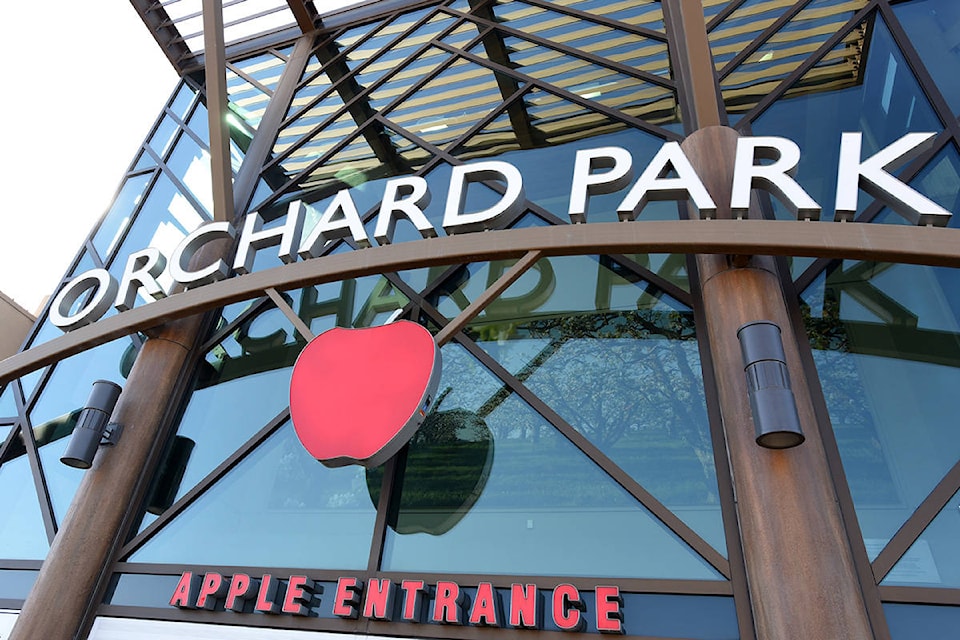- Story by David Wylie Photography by Don Denton
has been growing alongside Kelowna for five decades.
“Your shopping centre is the historic timeline for not only fashion, but the viability of the retail community in the city,” said Donna Markin, general manager for Orchard Park.
The iconic shopping centre opened September 28, 1971. When Orchard Park was developed on a former orchard, nothing else existed between its location and the Capri area—in fact, it was so far out of town, there was some skepticism in the community that people would actually go out of their way to shop there.
The shopping centre has been central to the City of Kelowna and the area’s growth. Economically, it’s the highest taxpayer in the community and a major employer with 1,000 people working at any time. Millions are spent there each year.
There is also a social side to the mall. For many young people, working there was their first job. It’s a popular meeting place and a focus of culture and couture.
Malls also serve as a gauge for the economic health of the community, said Donna.
“This is a 50-plus-acre piece of property and a 700,000-square-foot building—it doesn’t disappear very easily,” she said. “We have endured through the good and the bad years. It speaks to the resiliency of the mall business, its needs and its responsiveness to the community at large and what is happening.”
Steady growth
When it first opened in 1971, Orchard Park had two main anchors: Simpsons-Sears and The Bay (which was completed the following year). Inside, shoppers could visit 35 smaller stores.
“We’ve got a floor plan from the ’70s and some of those stores are still around,” said Donna. They include The Bay, Bootlegger, Tip Top, Purdy’s, Reitman’s, and The Source (which originally opened as Radio Shack).
And it’s not just stores that have weathered the passage of time. Holiday traditions also remain. Santa Claus has stayed consistent. Kids who had their picture taken with the Orchard Park Santa have returned as adults with their own kids in tow to get a picture with the same St. Nick—though perhaps a little bit older and greyer.
In 1980, the shopping centre expanded with the addition of Woolco. It also added a food court, a part of the overarching evolution of malls over time. The mall again grew its footprint when Eaton’s opened in 1992. Twenty years later, in 2011, the mall reached its current size of 707,000 square feet when Best Buy opened.
Run by Primaris Management Inc., there are more than 160 shops and services in the shopping centre, and it’s the largest mall between Greater Vancouver and the Calgary area.
Evolution
Historically, a shopping centre couldn’t be built without first securing a lease from a department store. But that’s changed, said Donna. Top department stores have been going bankrupt, leaving large spaces to suddenly fill.
“If I look at the evolution of shopping centres, I would say that the traditional mix of a shopping centre will change in the future. All of that is a response to the consumer and what they’re buying at what time.”
Shopping centres are no longer simply a collection of clothing and shoe stores (although these are still an important part). Rather, there are numerous services too, including salons, dentists, travel agencies, financial assistance companies and insurance brokers.
Death of the shopping centre exaggerated
Malls have been changing with the times.
“I think a lot of people get their information about the death of shopping centres out of the US,” Donna said.
Across the border, malls are built much closer to each other than in Canada, with some located just blocks away. As the population ages and consumer habits change, some centres have been forced to close due to an overabundance of them.
“You’re going to see more of what we’ve always done. We adapt and we change to what the consumer is needing and looking for; that is the hallmark of shopping centres,” said Donna.
“I’m very excited about what the future looks like.”
She said successful stores of the future will have a combination of brick-and-mortar stores and a digital platform. Some stores are doing showcasing—where they don’t actually sell anything in the store, but rather customers view merchandise in-store and order online. Other stores take the opposite approach, where customers can only buy in-store, but will be able to compare prices and do research online, or order online and pick up in store.
“There will be innumerable variations, and I believe that Orchard Park will be part of that. It’s not going to happen overnight, but that will be ultimately where we end up.”
Generous spirit
Operations manager Ron Stevenson said being charitable has always been a big part of Orchard Park’s culture.
“Because we’re so well supported by the community, we really find it necessary to give back as much as we can,” he said. “One of the initiatives that we are most proud of is raising $500,000 for Canadian Mental Health Kelowna through our Annual Charity Golf Tournament.”
The company also supports many local charities and various school groups’ fundraising initiatives through gift card donations and a dedicated space in the shopping centre for non-profit organizations to promote themselves at no cost.
Orchard Park is also preserving history with two time capsules on the property, as part of a project done in conjunction with the City of Kelowna and the Kelowna Museum. They’re marked by a bronze and stainless steel apple sculpture created by Geert Maas. One is to be opened in 2030 and another in 2105—100 years after it was sealed up in 2005.
Extra fact:
It’s hard to miss the massive 800-square-foot Canada flag that waves at the mall’s northwest corner. The flagpole on the corner of Harvey and Cooper was part of a former Husky Station.
Story courtesy of , a Black Press Media publication
Like Boulevard Magazine on and follow them on



